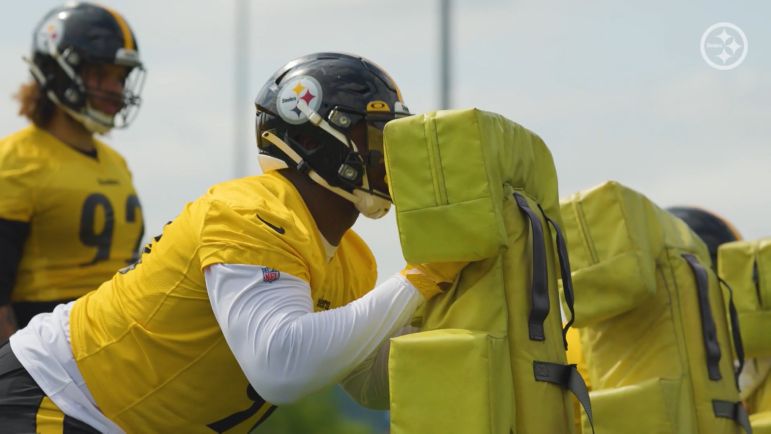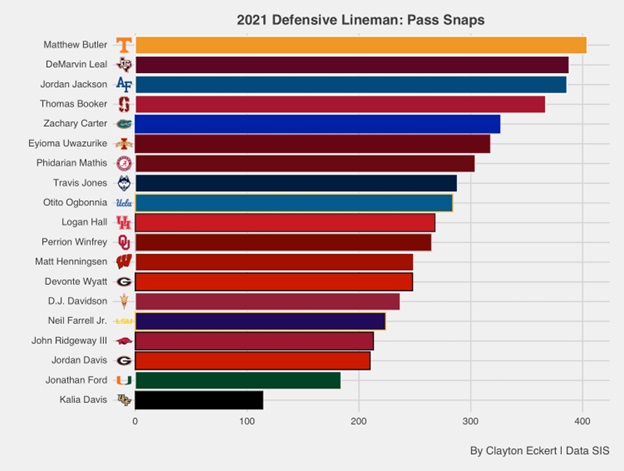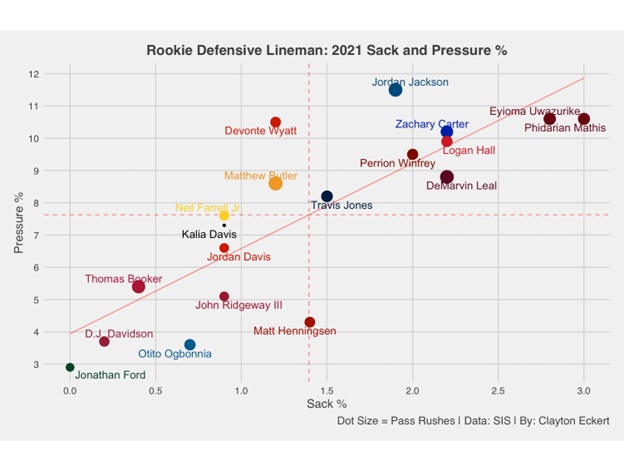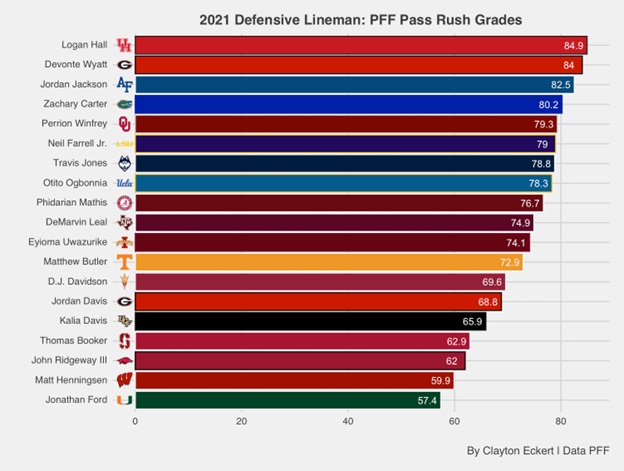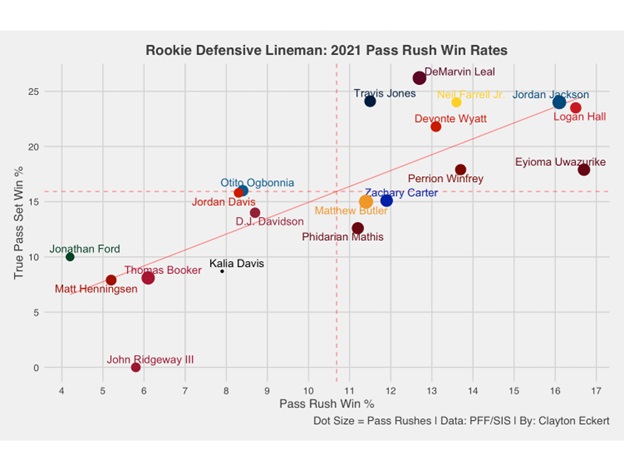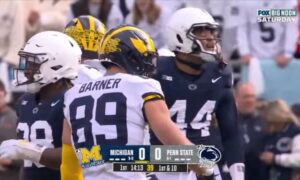Today I wanted to move to the defensive line, looking at and providing context in pass rushing situations last season using Sports Info Solutions (SIS) and Pro Football Focus (PFF). Similar to the other positions I’ve studied so far, I’m focusing on players selected in the 2022 NFL draft and excluding any small school players that SIS did not track. The goal is to see how Pittsburgh’s third round pick DeMarvin Leal fared amongst his peers in their final college season. Quick note before we dive in: with varying schemes and opinions on position groups, we’ll view players who weighed in at 275 pounds or more considering this fits Pittsburgh’s draft history.
First, let’s look at opportunity with pass snaps:
Right away we can see that Leal provided the second most pass rush snaps of the charted players, very important and encouraging context as we continue with the data. He was also one of only four players above 350 pass snaps, with a sizeable drop off that follows.
Now let’s add context to the players opportunities with sack percentage, pressure percentage (any play in which there is a quarterback hurry, hit, or knockdown), and the dot sizes highlighting the quantity with number of pass rushes:
Leal fared well last season, landing above the mean in both data points. Out of the 19 players on the graph, he tied for the third rank in sack percentage with Florida’s Zachary Carter (Bengals) and Houston’s Logan Hall (Buccaneers) who each had higher pressure percentages. Carter was also a third-round pick, selected 11 picks after Leal within the division, and it will be interesting to compare their opportunities and success as their careers get underway. The other players that were above Leal in both data points were Alabama’s Phidarian Mathis (Redskins) and Iowa State’s Eyioma Uwazurike (Broncos). Leal had a two-sack game against Mississippi State, both a result of the quarterback holding the ball too long, a takeaway our own Jonathan Heitritter made in this great pass rush film room.
Leal’s pressure percentage ranked eighth, highlighting moments of disappearance last season. While Leal impressively had at least one pressure in each game last season, his pass rush performance against Auburn was particularly quiet with 44 pass rushes and only one pressure. There were two other games in which he only had one pressure, one against South Carolina where he only had 15 pass rushes. The other was against Ole Miss, a game in which he provided a strip sack on quarterback Matt Corral. His best games in regards to pressure numbers were against LSU when he had 43 pass rushes, two assisted sacks, three hurries, two hits, one knockdown, for six total pressures, and Missouri with the same number of pass rushes, a solo sack, two hurries, three hits, for five total pressures.
To gain additional context to the pressure percentages, I wanted to view hits (any meaningful contact more than a light brush made by the defender on the quarterback before or after he releases the ball) and knockdowns to see which players made their presence felt physicality on opposing quarterbacks:
Interesting results after viewing the pressure percentages, and we can see Leal provided value here as well remaining above the mean in both data points. He provided the fourth most quarterback hits and tied for third in knockdowns, giving context to the type of pressure he was able to provide. In comparison, some players ranked high in pressure percentage when hurries were included, but fell lower in these results such as Carter, Uwazurike, and Oklahoma’s Perrion Winfrey (Browns).
Some examples of Leal’s hits were a result of long time to throw numbers as stated earlier. In the Alabama game, two of his three hits were scheme related, coming in unblocked on a five-man blitz and making contact into Bryce Young’s chest on the pass completion. The second was on a twist from right defensive tackle looping around the left end and able to get his hand on the quarterback, who was able to elude the pressure and scramble for the first down and more. Leal had two games with multiple knockdowns against Arkansas and Colorado, providing two in each. In the former he provided another spin move to the inside (highlighted earlier on one of his sacks) to get the knockdown and force the incompletion on third down.
Next, let’s see how the players fared in PFF pass rush grades:
PFF’s pass rush grade for Leal lands in the middle of the pack in their totality view of every play. The highs of his game are encouraging, but while he provided durability and availability had quiet stretches last season. His lowest graded game last season came in the quiet game mentioned earlier against Auburn (56.2). An interesting takeaway from the game splits was in his four lowest graded games, he had the most snaps of at least 45 pass rushes and up to 56 on two occasions. For comparison, looking at Hall’s top overall grade by game, his highest pass rush snap total was 39, which Leal eclipsed comfortably in five different games.
While it’s unlikely Leal will see that amount of playing time in the near future, we are fresh of a season where the position group was depleted by injury along with Stephon Tuitt’s retirement announcement. Our own Andrew Shaver provided a great breakdown of Leal’s pass rushing for his college career, highlighting his pressure rates dipping in the second half of games as well. While I’m not making any condemning proclamations, the data throughout the study seems to suggest that endurance could be worked upon, especially considering that Leal will likely need to bulk up and definitely add strength (only 17 reps on the bench at his pro day) to hopefully become a regular NFL contributor down the line, and in my opinion important to factor and track moving forward.
To close I wanted to add context to the PFF’s grades with pass rush win percentages (percentage of wins versus blocking on non-penalty pass rush snaps), and true pass set win percentage (excludes play action, screens, short dropbacks, and time to throw numbers under two seconds) to eliminate plays in which the pass rusher was less likely to produce:
Right away we see encouraging results for Leal with above the mean results in both data points again, along with the top rank in true pass set win percentage. This is very important context, considering the removed plays increasing the expectations and opportunities for higher win rates in true pass sets.
Overall, very encouraging results for Leal. He provided good availability along with the second most pass rush snaps, though his performance late in games and when highly utilized trailed off. He fared best in sack and pressure percentage, hits and knockdowns, pass rush and true pass set win percentages with the top rank in the latter. The only data in this study he was average in was his PFF pass rush grade, highlighting moments of disappearance last season. When he did get to the quarterback, he cashed in with sacks at a high rate compared to his peers, though some were of ‘less quality’ with indecisive quarterback play.
It will be interesting to see what Leal’s opportunities look like as a rookie, and especially interested to watch his development throughout his rookie year to see the beginnings of his growth into a hopeful starter down the line.
Throughout the rest of the offseason, I will dive deeper into the data as we continue to learn about the newest Pittsburgh Steelers. How do you think Leal will fare in his rookie year? Do you think he could provide a spark as a pass rusher? What are some of your takeaways across the league? Thanks for reading and let me know your thoughts in the comments!

